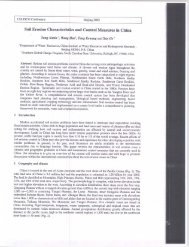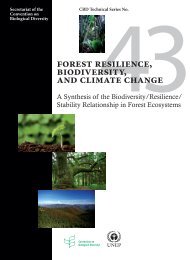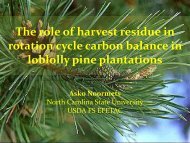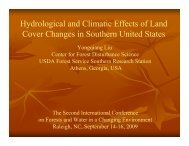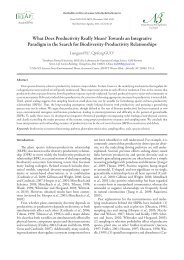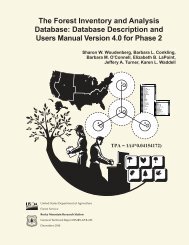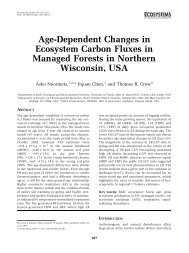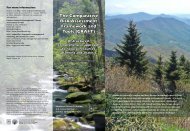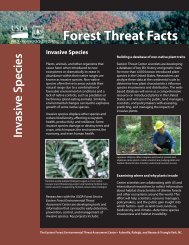What do forests have to do with global climate change? What do ...
What do forests have to do with global climate change? What do ...
What do forests have to do with global climate change? What do ...
You also want an ePaper? Increase the reach of your titles
YUMPU automatically turns print PDFs into web optimized ePapers that Google loves.
46<br />
(Pho<strong>to</strong> by Zoë Hoyle, U.S. Forest Service)<br />
Ice s<strong>to</strong>rms are disturbance events <strong>with</strong><br />
potential impacts on carbon sequestration.<br />
Common forest management practices,<br />
such as fertilization and thinning, can<br />
<strong>change</strong> wood and stand properties and<br />
may <strong>change</strong> vulnerability <strong>to</strong> ice s<strong>to</strong>rm<br />
damage. At the same time, increasing<br />
atmospheric CO 2 levels may also influence<br />
ice s<strong>to</strong>rm vulnerability. Results in the Duke<br />
Forest case study suggest that <strong>forests</strong> may<br />
suffer less damage during each ice s<strong>to</strong>rm<br />
event of similar severity in a future <strong>with</strong><br />
higher atmospheric CO 2.<br />
20 Miller, Ashley T.; Allen, H. Lee; Maier,<br />
Chris A. 2006. Quantifying the coarseroot<br />
biomass of intensively managed<br />
loblolly pine plantations. Canadian<br />
Journal of Forest Research. 36: 12-22.<br />
We assessed carbon accumulation in<br />
coarse roots of a loblolly pine plantation<br />
that was subjected <strong>to</strong> different levels of<br />
management intensity. Total belowground<br />
biomass was not affected by treatment.<br />
Vegetation control and disking increased<br />
pine taproot biomass and decreased<br />
hardwood taproot biomass. Pines between<br />
tree coarse roots were unaffected by<br />
treatment, but hardwoods between tree<br />
coarse roots were significantly reduced<br />
by vegetation control. Necromass was<br />
substantially lower than between-tree<br />
biomass, indicating decomposition of<br />
coarse-root biomass from the previous<br />
stand was rapid for between-tree coarse<br />
roots. Total aboveground biomass was<br />
increased by vegetation control, <strong>with</strong><br />
highest production on most intensively<br />
managed plots. Coarse-root biomass<br />
ranged from 19 <strong>to</strong> 24 percent of <strong>to</strong>tal<br />
biomass. Silvicultural practices increasing<br />
aboveground pine productivity did not<br />
increase <strong>to</strong>tal coarse-root biomass carbon<br />
because of the difference in root/shoot<br />
allocation between pine and hardwood<br />
species.<br />
21 Perry, Roger W.; Thill, Ronald E. 2007.<br />
Roost characteristics of hoary bats in<br />
Arkansas. American Midland Naturalist.<br />
158: 132-138.<br />
The hoary bat (Lasiurus cinereus) is the<br />
most widespread of all American bats, but<br />
little is known about its ecology, especially<br />
in the Eastern United States. Using<br />
radiotransmitters, we located 12 tree roosts<br />
during late spring and early summer in the<br />
Ouachita Mountains of central Arkansas.<br />
Hoary bats roosted about 16.5 m above<br />
the ground, generally on the easterly sides<br />
of tree canopies. Roosts were located in<br />
the foliage of white oaks (Quercus alba),<br />
post oaks (Q. stellata), and shortleaf<br />
pines (Pinus echinata), and all trees were<br />
>21 cm in diameter. All roosts were in<br />
forest stands <strong>do</strong>minated by mature (>50<br />
years old) overs<strong>to</strong>ry trees, and included<br />
unmanaged mixed pine-hardwood and<br />
hardwood stands, stands that recently had<br />
been thinned and subjected <strong>to</strong> prescribed<br />
burning, and stands that were thinned<br />
approximately 10 years previously. Results<br />
indicate hoary bats reproduce in Arkansas<br />
and roost in the foliage of both mature<br />
pines and hardwoods.<br />
22 Perry, Roger W.; Thill, Ronald E. 2007.<br />
Roost selection by male and female<br />
northern long-eared bats in a pine<strong>do</strong>minated<br />
landscape. Forest Ecology<br />
and Management. 247: 220-226.<br />
Roosts are critical <strong>to</strong> the survival of<br />
bats, but little information is available on<br />
roost selection by northern long-eared bats<br />
(Myotis septentrionalis) in pine-<strong>do</strong>minated<br />
<strong>forests</strong> of the Southeastern U.S. We used<br />
radiotransmitters <strong>to</strong> locate the summer<br />
daytime roosts of northern long-eared<br />
bats in <strong>forests</strong> of the Ouachita Mountains<br />
(Arkansas) <strong>to</strong> determine the types of roosts<br />
used, the habitats where those roosts were<br />
located, and how roosts differed between<br />
the sexes. Northern long-eared bats<br />
roosted mostly in dead trees (snags) where<br />
they concealed themselves in cavities,<br />
crevices, and under loose bark. Both sexes<br />
preferred shortleaf pine (Pinus echinata)<br />
snags over hardwood snags. Females<br />
roosted more in partially harvested or<br />
thinned forest stands than males and<br />
roosted in snags that were greater in<br />
diameter and surrounded by fewer<br />
mids<strong>to</strong>ry trees than males. Our results<br />
demonstrate the importance of maintaining<br />
pine snags for roosting by northern longeared<br />
bats and the importance <strong>to</strong> females<br />
of snags located in relatively open <strong>forests</strong>.<br />
23 Perry, Roger W.; Thill, Ronald E.<br />
2007. Tree roosting by male and female<br />
eastern pipistrelles in a forested<br />
landscape. Journal of Mammalogy. 88(4):<br />
974-981.<br />
compass—february compass—february 2008



